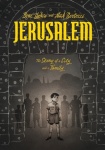
Jerusalem: A Family Portrait HC
Publisher: First Second
Release Date: April 2013
Price: $24.99
Writer: Boaz Yakin
Artist: Nick Bertozzi
Format: 385 pgs., Black & White, Hardcover
ISBN: 978-1-5964-3575-9
Age Rating: Mature
ICv2 Rating: 4 out of 5
Scholars and lay people alike share in the confusion and bewilderment surrounding the geopolitical, cultural, ethnic, and religious conflicts regarding the Middle East, particularly the ever-shifting morass enveloping the continued Arab-Israeli relations. The shifting allegiances and players change alongside fractured and contested borders, and seem all too familiar and common as an aspect of modern world history in our transnational, daily media culture. Yet, while screenwriter and filmmaker Boaz Yakin (The Punisher Movie Special, The Remarkable Worlds of Professor Phineas B. Fuddle) and Nick Bertozzi (Lewis and Clark, Strange Tales, Stuffed!) have shown that the root behind these conflicts dates back to the early decades of the twentieth century, the same shroud of confusion, bewilderment, and identity politics still remains just as troublesome.
In an attempt to disentangle the origins of this contemporary crisis and hopefully offer some clarity on the causes, Jerusalem not only shifts the focus away from the present and into the past, but also upon a single family struggling for survival in this transformative region and era; however, as the dustjacket so clearly states and the book strongly reinforces throughout the narrative, Jerusalem is "an all-too-real setting, when nothing was clear, and no path was smooth." Some audiences may find this aspect all too applicable to the work itself.
Abandoning a narrative of major, familiar players and omniscient political entities, Yakin instead pulls from his own history and stories, and centers upon three generations of the Halaby family. Set during World War II and the nation-building efforts of Israel from 1940 through 1948, Jerusalem is at once a roving tale of familial conflict and bitterness, triumphs and failures, as well as a story of seemingly never-ending violence between Israeli and Arab neighbors.
Following a brief, two-page overview of Jerusalem's varied history from 1517 through the formation of the World Zionist Congress in 1897, the outbreak of World War One and the Arab Revolt of 1936, to the 1939 White Paper immigration restrictions, Yakin provides readers with a Halaby family tree and their associates. While in the beginning, this family key offers clarity and quick reference for the revolving cast, it may prove quite cumbersome for some readers as both the Halaby family grows and the satellite characters enter and exit the story. Maintaining the identity of not only Yakov and Izak Halaby's children, but also the auxiliary members of the story is further impeded by the absence of a varied line in depicting Israeli and Arab cast members. At times the narrative becomes so busied with the internal machinations of sibling rivalry and family against family, that the external devices of the larger group politics (Zionist, Communist) alongside the nationalist interests of Arab, Israeli, and British players impede the flow and progression.
This is not, however, to say that Jerusalem is without its narrative merits. In fact, when Yakin focuses on the microcosm of Motti Halaby and his cousin Jonathan's school days and the linguistic punishments for speaking Arabic or Hebrew in an English and French-only curriculum, or in the completely silent moments where a fearful, young Jewish shopkeeper watches an impending Arab riot in the street and must depend on the security of a British police officer, the internal and external, familial and universal conflicts resonate in powerful and poignant ways. Sequences such as these allow Yakin and Bertozzi to succeed in their visual storytelling efforts.
Educators, particularly secondary high school teachers and college professors, will benefit from Jerusalem and its potentials for course adoption. Taught together with Joe Sacco's Palestine or Footnotes in Gaza, Sarah Glidden's How to Understand Israel in 60 Days or Less, and Guy Delisle's Jerusalem: Chronicles from the Holy City, Yakin and Bertozzi's Jerusalem makes an important contribution to the evolving canon of graphic literature on the Middle East. As such, Jerusalem is perfect for introductory World History or Modern Middle Eastern survey courses.
--Nathan Wilson


